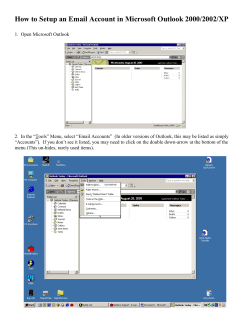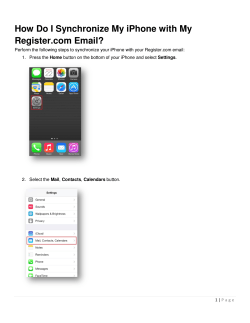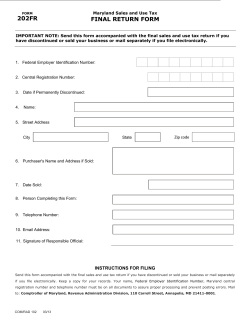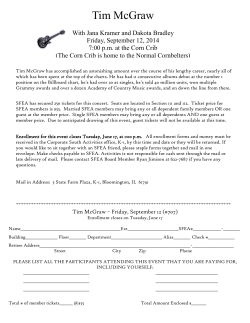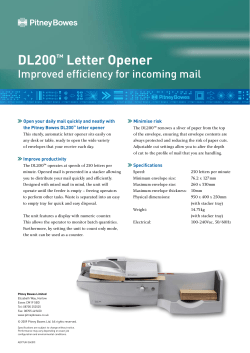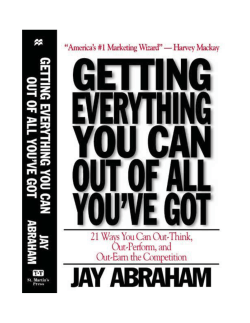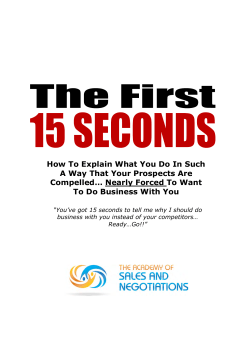
Research Study: Evidence Reveals How to Grow in Any Economy
Research Study: Evidence Reveals How to Grow in Any Economy Critical Strategies. Avoidable Mistakes. New Business Approaches. The Study This study was developed as a public relations effort and as a way for us to help the companies we work with to grow and prosper. When they grow… we grow! Researched and produced by © Copyright - 2010 2 Do you know? • What percentage of companies reach $1 million in annual revenue? • How about $5 million? Source: Chet Holmes author of The Ultimate Sales Machine: Census Bureau © Copyright - 2010 3 The reality… • Only 5% of companies will ever reach $1 million in annual sales • Only .08% will reach $5 million Source: Chet Holmes author of The Ultimate Sales Machine: Census Bureau © Copyright - 2010 4 Business stagnancy in the U.S. • • Only 30% of businesses survive and only 10% of these businesses grow This means, 90% of all businesses become stagnant! 90% 80% 70% Where are you? 60% 50% 40% • Typically, growth is stunted when business climates change… buyer spending habits, new competition, product supply and demand 30% 20% 10% 0% Stagnant Growing Source: Office of Advocacy of the U.S. Small Business Administration adapted from the Bureau of the Census Economic Survey © Copyright - 2010 5 Major drivers of stagnancy In a review of businesses that failed to grow, the majority struggled in 4 key areas: Management Business Planning Financial Planning Marketing Source: U.S. Bank Study Business Failure 2008 © Copyright - 2010 6 Focus on Marketing • 60% of business owners that failed to grow listed poor marketing as a critical contributor and ▪ half of these business owners rated themselves “low” or “very low” in their marketing skills • 60% of business executives surveyed lack confidence in their marketing decisions and believe their marketing could be more effective • 50% are not satisfied with the time spent on marketing their companies SOURCES: U.S. SMALL BUSINESS CONTRACT # SBA-95-0403, PAPER FINANCIAL DIFFICULTIES OF SMALL BUSINESS AND REASONS FOR THEIR FAILURE (1998); D. BRADLEY III & H. MOORE, “SMALL BUSINESS BANKRUPTCY CAUSED BY LACK OF UNDERSTANDING OF BUSINESS ENVIRONMENT AND CONSUMER NEEDS,” SMALL BUSINESS ADVANCEMENT NATIONAL CENTER, 1997; . REDEFINING BUSINESS SUCCESS: DISTINGUISHING BETWEEN CLOSURE AND FAILURE, SMALL BUSINESS ECONOMICS, AUGUST 2003, : “HP SURVEY REVEALS TOP U.S. BUSINESS MARKETING CHALLENGES,” BUSINESS WIRE, FEBRUARY 2008 © Copyright - 2010 7 Expertise is required in critical areas However, less than 30% of mid-sized companies feel they are competent in every marketing area Competent Could do more Barely surviving Branding 28% Advertising 26% 47% Print Collateral 24% 54% Direct Mail 23% Haven’t started 61% 41% 7% 5% 16% 12% 20% 11% 11% 16% Take a moment and rate yourself…. SOURCES: FIRST ANNUAL MIDMARKETER AWARENESS SURVEY RESULTS, 2008 © Copyright - 2010 8 Market share is becoming increasingly difficult to achieve • In 2005, more than 156,000 products debuted in stores globally: one every 3 seconds – 75% of these failed • Roughly 21,000 new brands are introduced worldwide per year – 52% of these will fail Source: SDL Maidenhead – July 6th, 2007 – Companies struggle to manage brands © Copyright - 2010 9 Four Major Marketing Mistakes 10 Mistake #1: Cutting Budgets… when aggressive action should be taken Ask yourself right now…. When is the best time to market aggressively? 11 During a recession! Competitors cut back on marketing expenditures Less competition enters the market Window of opportunity - 86% of executives agree advertising in a down economy keeps a company at the front of the audience’s mind Major brands that invested in marketing campaigns weathered the effects of the 2001 recession — those that didn’t lost market share ……..or worse SOURCE: BROOKS, D. & SEE, E. “THE SALES THREATS THAT CAN CRIPPLE MARKETING: YOU CAN'T CONTROL GAS PRICES, WEATHER OR COMPETITION-BUT YOU CAN REACT,” ADVERTISING AGE, JUNE 16, 2008: MARKETING INSIGHTS – REF. HARRIS STUDY 2008 © Copyright - 2010 12 Advertising can prevent stagnation A McGraw-Hill study examined nearly 600 businesses from 1980 - 1985 and found: Companies that advertised aggressively during the recession had sales 256% higher than those that did not continue to advertise And… firms that chose to maintain or raise their level of advertising expenditures during the 1981-1982 recession had significantly higher sales after the economy recovered Source: Advertising during Times of Economic Uncertainty.” American Business Media – Association of Business Information Companies; 2008. © Copyright - 2010 13 On the other hand…. Percent Drop in Revenues • Reducing ad spending by 50% for just one year caused revenues to drop 23% • And it took 2 full years to recover! Source: Forbes Magazine, June 2008 © Copyright - 2010 14 The more you cut - the more you lose! Percent Drop in Revenues • Totally eliminating ad spending caused a 75% drop in revenues • Full recovery took 5 years Source: Forbes Magazine, June 2008 © Copyright - 2010 15 A Case Study Everyone drinks milk right? Well that’s what milk producers thought! • To cut costs, U.S. milk ads were pulled in the early 1990s • Sales went unchanged for 12 months • Then… sales began plummeting at alarming rates Source: Marketing Daily Commentary, April 2, 2009, Wasting Money on Advertising by Gray Hammond © Copyright - 2010 16 The reality behind the cost-cutting decision • Millions were lost and it took 18 months for sales to rebound! • Apparently, it’s important to constantly remind buyers… “Milk Does A Body Good” • Remember… sales can plummet in as little as three months for any company in any environment Source: Marketing Daily Commentary, April 2, 2009, Wasting Money on Advertising by Gray Hammond BROOKS, D. & SEE, E. “THE SALES THREATS THAT CAN CRIPPLE MARKETING: YOU CAN'T CONTROL GAS PRICES, WEATHER OR COMPETITION-BUT YOU CAN REACT,” ADVERTISING AGE, JUNE 16, 2008: MARKETING INSIGHTS – REF. HARRIS STUDY 2008 © Copyright - 2010 17 Mistake #2: Not Making the Right Advertising Choices 18 Which will work? The Fournaise Business Papers Marketing Group, one of the global leaders in tracking media marketing Internet effectiveness, revealed 60% of 2008’s worldwide advertising spending failed to deliver the Outdoor results expected by their marketers and was considered wasted advertising Direct Mail expenditures Newspaper Magazine TV/Cable Radio Yellow Pages Source: The Fournaise Marketing Group: 60% of Advertising Spending was wasted in 2008: Author: Otilia Otlacan: January 2009 © Copyright - 2010 19 Costs are up… effectiveness is down Total U.S. newspaper circulation figures: 1990: 62,328,000 2008: 48,597,000 (down 22%) $210,300 $105,532 Yet the cost of newspaper advertising per unit of circulation has doubled since 1990 Wall Street Journal 1990 2009 Source: BusinessWeek July 12 2004 http://www.businessweek.com/magazine/content/04_28/b3891001_mz001.htm, Newspaper Association of America http://www.naa.org/TrendsandNumbers/Total-Paid-Circulation.aspx © Copyright - 2010 20 Commercial skipping is costing TV advertisers $4 billion dollars • A staggering 90% of people on TiVo skip past ads • 78% of advertisers say TV advertising has become less effective Source: “The DVR Dilemma: Managing Consumer Behavior”; www.jupiterresearch.com, http://www.ehomeupgrade.com/2006/05/05/ dvr-commercial-skipping-could-threaten-8-billion-in-tv-advertising/; http://blogs.zdnet.com/ITFacts/?p=10466 © Copyright - 2010 21 What about print collateral and direct mail? • 76% of companies are not competent in designing print collateral/direct mail - mass marketing is typically the focus • "I did a mailing once and never got any business.” • Experts say it takes 6 – 12 times of making repeated contact before a buyer is in a purchasereadiness mode SOURCES: FIRST ANNUAL MIDMARKETER AWARENESS SURVEY RESULTS, 2008 © Copyright - 2010 22 Email is becoming less effective • • • • 30% of email marketing is blocked by SPAM filters 69% of email is deleted based on the subject line 30% of subscribers change email addresses annually Subscribers below age 25 prefer SMS (short message service or texting) to email Source: ClickZ.com Seven Signs You Need to Revive Your Permissions Database By Jeanniey Mullen Aug 31, 2009 Convinceandconvert.com 15 Email Statistics That Are Shaping The Future author: Jay Baer © Copyright - 2010 23 Mistake #3: Not Marketing to Your Buyers Like You Know Who They Are 24 Doors are being slammed shut every day! • From 1996 to 2008 the number of marketing messages per day increased nearly tenfold (1,000%) • Today’s over stimulated, ultra-sensitive and less affluent buyer is bombarded with 100s to1000s of options • On the other hand, the more connected and inspired buyers feel, the more receptive they are to ad messages… building that emotional tie is the most difficult aspect SOURCES: TALKTRACK™, KELLER FAY GROUP, 2006; UNION OF CONCERNED SCIENTISTS WEBSITE MARITZ DIALOGUE MARKETING GROUP © Copyright - 2010 25 Buyers Pay Attention to what is Relevant to them • The new buyer “now” decides what they will entertain and which companies they will tolerate messages from • Increasing relevancy has been shown to increase consumer response by 500%! SOURCE: ROMANO AND BROUDY © Copyright - 2010 26 Mistake #4: Utilizing Ineffective Advertising Techniques 27 Mass Marketing • Companies find it hard to reach targeted groups of buyers so they still rely on the ineffective one-way mass marketing to push a product to many buyers Old Brunette Young Blonde Married Bald Single Military Source: Harvard Business Review, Rethinking Marketing, Roland T. Rust, Christine Moorman, and Gaurav Bhalla, Jan–Feb 2010 © Copyright - 2010 28 So… how do you get through the maze with a series of effective messages to your target audience? 29 3 Marketing Strategies Designed to Grow your Company 1. Really Know Your Target Audience 2. Use Best Practices Marketing Techniques 3. Use tactics you can target AND measure 30 Strategy #1: Really Know Your Target Audience – Add Demographics Income, Home Value, Age Pets or Children in the Home Comic Book Reader Stamp Collector Wine Connoisseur Wildlife Donor SIC Code Annual Sales Decision Maker’s Title © Copyright - 2010 31 Adding Demos to your customer list Here’s an example: Stock coaching firm adds demos expecting to find clients are largely “likely investors” Turns out, only 18% were coded as likely investors while 75% like to travel. Conclusion: order lists of those with a travel interest, run ads in travel magazines, etc. © Copyright - 2010 32 Strategy #2: Use Best Practices Marketing Techniques Effective marketing has 5 specific traits 1. It Must Be Distinctive — Catches and holds the eye 2. The Copy Must Educate and Focus on Your Prospects, not on you. 3. Captures Attention With a Screaming Headline Source: The Ultimate Sales Machine author: Chet Holmes pg. 119-122 © Copyright - 2010 33 Continued… 4. Your body copy has to keep them reading. 5. Tell your prospect what you want them to do. Give them a Call to Action. Source: The Ultimate Sales Machine author: Chet Holmes pg. 119-122 © Copyright - 2010 34 Strategy #3: Use tactics you can target AND measure • Targeted and measurable are the hallmarks of any effective marketing campaign. • New low-cost technology can create highly individualized direct mail that can be easily targeted and measured. © Copyright - 2010 35 7 Musts of Marketing for Top of Mind Awareness a McGraw Hill Study Advertising Personal Contact Direct Mail Public Relations Internet Trade Shows Corporate Literature Source: McGraw Hill: Chet Holmes: The Ultimate Sales Machine, Nash, Edward L., ed. The Direct Marketing Handbook, 2nd ed. McGraw-Hill, 1992 36 Why use Direct Mail? It’s still producing. Direct Mail’s ROI is increasing even in today’s climate an investment of $1 in direct marketing advertising, on average, across all industries, produced in incremental revenue … even in a downturn of: • $11.61 - 2008 • $11.65 - 2009 • $11.73 - 2010 (projected) Reasons for ROI increase Better list management More sophisticated targeting Better measurement techniques mean you can modify the campaign based on results # of mail items a household receives today has decreased – less clutter factor Source: DMA: Power of Direct Marketing Report December 29, 2009: 2009 Direct Marketing Association: Response Rate Report: March 3, 2009 © Copyright - 2010 37 Why use Direct Mail? It’s still preferred. A CMO study asked the following question: What are your preferred methods for companies to contact you about product or service promotions? 51% Traditional Mail 43% Email 5% Online Banners 1% Phone Source: The Chief Marketing Officer (CMO) Council 2009 Why Relevance Drives Response and Relationships © Copyright - 2010 38 Use Direct Mail to Drive Online Traffic According to the 2009 Channel Preference Study by ExactTarget “Direct mail influences 76% of Internet users to buy a product or service online." © Copyright - 2010 39 7 Steps to Revenue Producing Marketing © Copyright - 2010 40 Step #1: Right Audience • Add demographics to current client list to determine your target market • Add ways to gather information about your target via in-store, online, direct mail surveys, etc. • Explore mailing list options • Develop “Dream Prospect” list © Copyright - 2010 41 Step #1: Right Audience cont. Dream Prospect definition: • Ideal prospects that make your company profitable. • Prospects who buy often, in large quantities and at higher margins. Example Telephone Equipment Company Businesses (36,000) Businesses with older systems (9,000) Businesses with older phone systems that have over 100 employees (600) © Copyright - 2010 42 Step #2: Right Messaging • You only have 3.5 seconds to get their attention! We have a chair for you. • Describe and emphasize what makes you different from your competition Teachertoto Teacher Principalinin Principal 5 Quarters Quarters © Copyright - 2010 43 Step #3: Relevancy • 85% of the information taken into the brain enters through the eyes • Global research shows drastic differences in the Visual Desires of different demographics; countries, states, ages, genders, occupations, education and income levels • Recent research in neuroscience proves our eyes know what we will choose before we realize our decision Source: The Ultimate Sales Machine author: Chet Holmes pg. 148: Business Wire Press Release Source: Visual Targeting April 17, 2010, 5:22 pm EDT © Copyright - 2010 44 One-to-One Marketing Gets Noticed Each piece can be customized based on demographic/ firmagraphic data © Copyright - 2010 45 Step #4: Offers • Your ‘Offer’ can have a 500% impact on response rates, up or down • It can make the difference between a 2% response rate and a 10% response rate Source: Conversion Multiplier: 2008 Survey © Copyright - 2010 46 Step #5: Tracking and Measurement 800 number technology can track which prospects were motivated to call on which offer or campaign. New Personalized URL technology can track which prospects hit your website. New Personalized URL technology can track which prospects hit your website. www.Top4Reasons.com\Test.Perso www.HowBizsGrow.com\Jane.Doe © Copyright - 2010 47 The amazing results of a PURL • According to the article “PURLs of Wisdom”, “Personalization allows direct mail, to obtain returns greater than 5 percent. Some of the more effectively designed programs can achieve returns of 20 to 30 percent.” • According to the Direct Marketing Association (DMA) 43% of buyers prefer to respond to an advertisement online. Source: Direct Marketing Association 2009 © Copyright - 2010 48 Two Studies Put Together From: § 51% preferred traditional mail § 43% prefer to respond to an advertisement online We would conclude that providing a PURL site for interested buyers would produce the greatest return. Source: Direct Marketing Association 2009 © Copyright - 2010 49 Step #6: Repeated Campaigns Consistent marketing messages and multiple repetitions over at least a year will help increase long term sales • Builds awareness • Builds credibility • Creates a level of trust • Conveys that your business is established • Keeps you fresh in their minds Purchasing Time for Buyers 47% 25% 17% 11% 3 Months 4-6 Months 7-12 Months 1+ Year Source: Cahners Business Information Study and Vistage Survey cited by DMN3 © Copyright - 2010 50 And finally…..Step #7: Testing Modify and fine tune the strategy Develop a strategy Test the strategy Do it again! © Copyright - 2010 51 A quick word from our sponsor 52
© Copyright 2025


